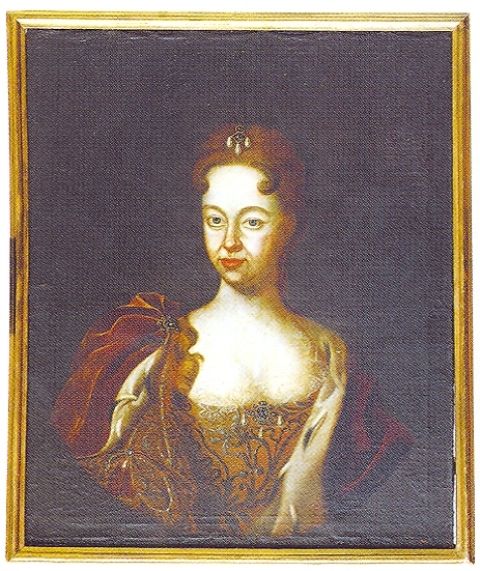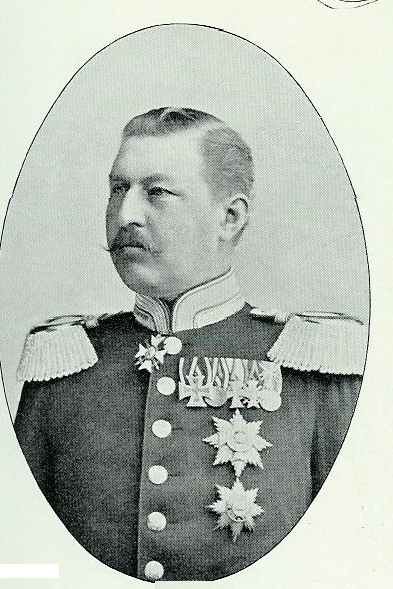by Susan Flantzer
© Unofficial Royalty 2023

Auguste of Anhalt-Dessau, Princess of Schwarzburg-Rudolstadt; Credit – Wikipedia
Principality of Schwarzburg-Rudolstadt and the Principality of Schwarzburg-Sondershausen: The County of Schwarzburg was a state of the Holy Roman Empire from 1195 to 1595, when it was partitioned into Schwarzburg-Rudolstadt and Schwarzburg-Sondershausen. The new counties remained in the Holy Roman Empire until its dissolution. In 1697, the County of Schwarzburg-Sondershausen was elevated to the Principality of Schwarzburg-Sondershausen. The County of Schwarzburg-Rudolstadt was elevated to the Principality of Schwarzburg-Rudolstadt in 1710.
The death of Karl Günther, Prince of Schwarzburg-Sondershausen without an heir in 1909 caused the Principalities of Schwarzburg-Rudolstadt and Schwarzburg-Sondershausen to be united under Günther Victor, Prince of Schwarzburg-Rudolstadt in a personal union. Following his succession in Sondershausen, Prince Günther Victor dropped the name Rudolstadt from his title and assumed the title Prince of Schwarzburg.
At the end of World War I, Prince Günther Victor was the last German prince to renounce his throne, abdicating on November 22, 1918. He made an agreement with the government that awarded him an annual pension and the right to use several of the family residences. The territory that encompassed the Principalities of Schwarzburg-Rudolstadt and Schwarzburg-Sondershausen is now located in the German state of Thuringia.
********************
The first wife of the three wives of Friedrich Günther, Prince of Schwarzburg-Rudolstadt, Princess Auguste of Anhalt-Dessau was born on August 18, 1793, in Dessau, then in the Duchy of Anhalt-Dessau, now in the German state of Saxony-Anhalt. She was given the names Amalie Auguste but was called Auguste. Auguste was the eldest of the seven children and the elder of the two daughters of Friedrich, Hereditary Prince of Anhalt-Dessau, and Landgravine Amalie of Hesse-Homburg. Her paternal grandparents were Leopold III, Duke of Anhalt-Dessau and Princess Luise of Brandenburg-Schwedt. Auguste’s maternal grandparents were Friedrich V, Landgrave of Hesse-Homburg, and Princess Karoline of Hesse-Darmstadt.

Auguste, on the right, with her mother and her siblings Leopold and Georg; Credit – Wikipedia
Auguste had six younger siblings:
- Leopold IV Friedrich, Duke of Anhalt (1794 – 1871), married Princess Friederike of Prussia, had four children
- Prince Georg of Anhalt-Dessau (1796 – 1865), married (1) Princess Karoline of Schwarzburg-Rudolstadt, had two children (2) married morganatically Therese Emma von Erdmannsdorff, had seven children including the second wife of Friedrich Günther, Prince of Schwarzburg-Rudolstadt
- Prince Paul of Anhalt-Dessau (born and died 1797), died in infancy
- Princess Luise of Anhalt-Dessau (1798 – 1858), married her maternal uncle Gustav, Landgrave of Hesse-Homburg, had three children
- Prince Friedrich August of Anhalt-Dessau (1799 – 1864), married Princess Marie Luise Charlotte of Hesse-Kassel, had three children
- Prince Wilhelm of Anhalt-Dessau (1807 – 1864), married morganatically Emilie Klausnitzer, no children

Kavalierstrasse in Dessau with the Hereditary Prince’s Palace on the left; Credit – Wikipedia
Auguste grew up with her family at the Hereditary Prince’s Palace on Kavalierstrasse in Dessau. Her mother Amalie personally and thoroughly took care of the upbringing and education of her children.

Friedrich Günther, Prince of Schwarzburg-Rudolstadt; Credit – Wikipedia
On April 15, 1816, in her hometown of Dessau, 23-year-old Auguste married her first cousin Friedrich Günther, Prince of Schwarzburg-Rudolstadt, who was also 23 years old. Friedrich Günther was the son of Ludwig Friedrich II, Prince of Schwarzburg-Rudolstadt and Auguste’s maternal aunt Landgravine Karoline of Hesse-Homburg. When his father died in 1807, 14-year-old Friedrich Günther became the reigning Prince of Schwarzburg-Rudolstadt with his mother Karoline serving as Regent of Schwarzburg-Rudolstadt until he came of age in 1814.
Auguste and Friedrich Günther had three sons. All three predeceased their father, leaving Friedrich Günther with no male heirs.
- Friedrich Günther, Hereditary Prince of Schwarzburg-Rudolstadt (1818 – 1821), died in early childhood
- Günther of Schwarzburg-Rudolstadt, Hereditary Prince of Schwarzburg-Rudolstadt (1821 – 1845), unmarried, died in his 20s
- Prince Gustav of Schwarzburg-Rudolstadt (1828 – 1837), died in childhood
Auguste was popular with the people of Schwarzburg-Rudolstadt and was a supporter of the arts and sciences. She died, aged 60, on June 12, 1854, in Rudolstadt, Principality of Schwarzburg-Rudolstadt, now in the German state of Thuringia, and was buried in the Alter Friedhof/Garnisonfriedhof (Old Cemetery/Garrison Cemetery) in Rudolstadt. When that cemetery was closed sometime after 1869, Auguste’s remains were moved to the Schlosskirche Schwarzburg (link in German), the castle church at Schwarzburg Castle in Schwarzburg, now in the German state of Thuringia. Her remains were moved a second time to the Stadtkirche St. Andreas (link in German) in Rudolstadt, Thuringia, Germany before the demolition of the Schlosskirche Schwarzburg in the early 1940s.

Stadtkirche St. Andreas; Credit – Wikipedia
A year after Auguste’s death Friedrich Günther married Countess Helene of Reina (1835 – 1860). Helene was the daughter of Auguste’s brother Prince Georg of Anhalt-Dessau from his morganatic, second marriage. Although Helene was adopted by her paternal uncle Prince Wilhelm of Anhalt shortly before her marriage and assumed the title of Princess of Anhalt, her marriage to Friedrich Günther was considered morganatic under the House Laws of the Schwarzburg family. They had a set of twins, one boy and one girl, but Helene, aged 25, died three days after their birth. Friedrich Günther married for a third time to Marie Schultze (1840 – 1909) in 1861, but the marriage was also morganatic and was childless. Friedrich Günther survived his first wife Auguste by thirteen years, dying on June 28, 1867, at the age of 73. Friedrich Günther was succeeded by his brother Albrecht as all of his sons by Auguste had predeceased him and his son by his second wife was born from a morganatic marriage.
This article is the intellectual property of Unofficial Royalty and is NOT TO BE COPIED, EDITED, OR POSTED IN ANY FORM ON ANOTHER WEBSITE under any circumstances. It is permissible to use a link that directs to Unofficial Royalty.
Works Cited
- Flantzer, Susan. (2022). Friedrich Günther, Prince of Schwarzburg-Rudolstadt. Unofficial Royalty. https://www.unofficialroyalty.com/friedrich-gunther-prince-of-schwarzburg-rudolstadt/
- Wikimedia Foundation. (2023). Amalie von Hessen-Homburg. Wikipedia (German). https://de.wikipedia.org/wiki/Amalie_von_Hessen-Homburg
- Wikimedia Foundation. (2023). Auguste von Anhalt-Dessau. Wikipedia (German). https://de.wikipedia.org/wiki/Auguste_von_Anhalt-Dessau
- Wikimedia Foundation. (2022). Friedrich von Anhalt-Dessau. Wikipedia (German). https://de.wikipedia.org/wiki/Friedrich_von_Anhalt-Dessau
- Wikimedia Foundation. (2022). Auguste of Anhalt-Dessau. Wikipedia. https://en.wikipedia.org/wiki/Auguste_of_Anhalt-Dessau
- Wikimedia Foundation. (2023). Erbprinzliches Palais Dessau. Wikipedia. https://en.wikipedia.org/wiki/Erbprinzliches_Palais_Dessau


























